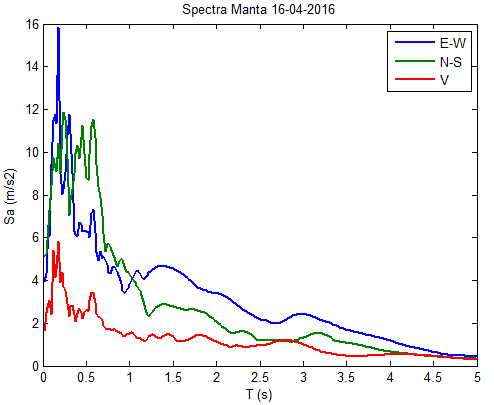Reinforcement of an industrial structure with two types of energy dispensers
DOI:
https://doi.org/10.13140/RG.2.2.34727.96161Keywords:
shear Link power dissipators, TADAS power dissipators, seismic reinforcement of an industrial structure, earthquake april 16 EcuadorAbstract
This paper presents the reinforcement of a flour storage silo affected by the earthquake of April 16, 2016, in ECUADOR, which had a moment magnitude of 7.8. Immediately after the earthquake carbon fiber was placed in the affected elements and the block masonry was changed with light walls in such a way to continue working. A seismic hazard study was carried out and two uniform seismic hazard spectra were determined for 975 and 2475 years of return period. To reinforce this structure it is proposed to place steel diagonals in the subsoil, in such a way that the loads that are generated go directly to the foundation. On the ground floor will be placed Shear Link power dissipators and on the next floor high TADAS heat sinks. The reinforced structure was analyzed for the spectra obtained in Manta from the earthquake of April 16 and for the two earthquakes of uniform seismic hazard indicated.
Downloads
References
[2] W. Mera, “Estudio de la vulnerabilidad sísmica-estructural de los edificios de Molinos Superior de la ciudad de Manta”, Consultoría Estructural. Segundo Informe. Guayaquil, pp 27, 2016
[3] R. Aguiar y J. Mieles, “Análisis de los edificios que colapsaron en Portoviejo durante el terremoto del 16 de abril de 2016”, Revista Internacional de Ingeniería de Estructuras, vol. 21, no 3, pp 275-285, 2016, Disponible en: http://www.riie.espe.edu.ec
[4] R. Aguiar, F. Del Castillo, L. Mizobe, P. Mendoza, “Rehabilitación de edificio afectado por el terremoto del 16 de abril de 2016 de Ecuador en la ULEAM”, Revista Gaceta Técnica, vol. 15, no 1, pp 9-22, 2016.
[5] A. Filiatrault, “Seismic design and analysis of nonstructural components, Chapter 5 Seismic performance of cold-formed steel framed Gypsum partition walls” Material entregado en el XX Curso Internacional de Estructuras realizado en la Universidad de Fuerzas Armadas ESPE, en Ecuador, 2015.
[6] W. Mera, “Estudio de la vulnerabilidad sísmica-estructural de los edificios de Molinos Superior de la ciudad de Manta”, Consultoría Estructural. Primer informe. Guayaquil, pp 23, 2016.
[7] K. Campbell, Y. Borzognia, “NGA-West2 Ground Motion Model for the Average Horizontal Components of PGA, PGV, and 5% damped linear acceleration response spectra” Earthquaek Spectra, vol 30 no 2, pp 1087-1115, 2014.
[8] N. Abrahamson, W. Silva, and R. Kamai, “Summary of the ASK14 ground motion relation for active crystal regions”, Earthquake Spectra, vol 30 no 3, pp 1025-1055, 2014.
[9] B. Chiou, R. Youngs, “Update of the Chiou and Youngs NGA model for the average horizontal component of peak ground and response spectra”, Earthquake Spectra, vol. 30 no 3, pp 1117-1153, 2014
[10] R. Aguiar, M. Rodríguez, D. Mora, “Análisis sísmico de estructuras con disipadores ADAS o TADAS”, Centro Internacional de Métodos Numéricos en Ingeniería Sísmica CIMNE, IS-73, pp 174, 2016.
[11] Instituto Geofísico, “Informes sobre el terremoto de Muisne del 16 de abril de 2016”, Escuela Politécnica Nacional, Quito, 2016.
[12] R. Aguiar, “Dinámica de Estructuras con CEINCI-LAB”, Universidad de las Fuerzas Armadas ESPE. Segunda Edición, pp 416, 2012.
[13] R. Aguiar, “Análisis Matricial de Estructuras con CEINCI-LAB”, Universidad de las Fuerzas Armadas ESPE, Cuarta Edición, pp 676, 2014.
[14] A. Barbat, S. Oller, y J. C. Vielma, “Cálculo y diseño sismo resistente de edificios. Aplicación de la Norma NCSE-02”, Centro Internacional de Métodos Numéricos en Ingeniería, Monografía de Ingeniería Sísmica, IS 56, pp 183, 2005.
[15] J.C. Vielma y M. Cando, “Evaluación de estructuras metálicas, proyectadas conforme a Norma Ecuatoriana de la Construcción mediante análisis no lineal”, Revista Ciencia, vol. 16, no. 2, 175-191, 2014.
[16] A. Chopra, “Dynamic of structures: Theory and applications to earthquake engineering”, 2nd edn. Prentice Hall: Saddle River New York
[17] R. Aguiar, D. Muñoz, S. Serrano, “Reforzamiento del Bloque Estructural del parqueadero de la ULEAM, afectada por el terremoto del 16 de abril de 2016”, Revista Internacional de Ingeniería de Estructuras, vol. 21 no. 3, pp 301-317, 2016.
[18] L. Bozzo, “Simulación numérica. Disipador Bozzo inserto en tubo”, Informe Técnico, pp 16, Lima, 2016
[19] K-C Tsai, H-W Chen, C-P Hong, Y-F Su, “Design of steel triangular plate energy absorbers for seismic-resistant construction”, Earthquake Spectra, vol. 9, no. 3, pp 505-528, 1993
[20] A. Tena, H. J. Nangullasmú-Hernández, “Assessment of seismic design parameters of moment resisting RC braced frames with metallic fuses”, Engineering Structures, vol. 95, pp. 138-153, 2015.
[21] NEC-15, “Norma Ecuatoriana de la Construcción”, Ministerio de la Vivienda MIDUVI, 2015.

Published
How to Cite
Issue
Section
The opinions expressed by the authors do not necessarily reflect the position of the editor of the publication or UCLA. The total or partial reproduction of the texts published here is authorized, provided that the complete source and electronic address of this journal is cited. Authors have the right to use their articles for any purpose as long as it is done nonprofit. The authors can post on the internet or any other media the final approved version of their work.






.png)




